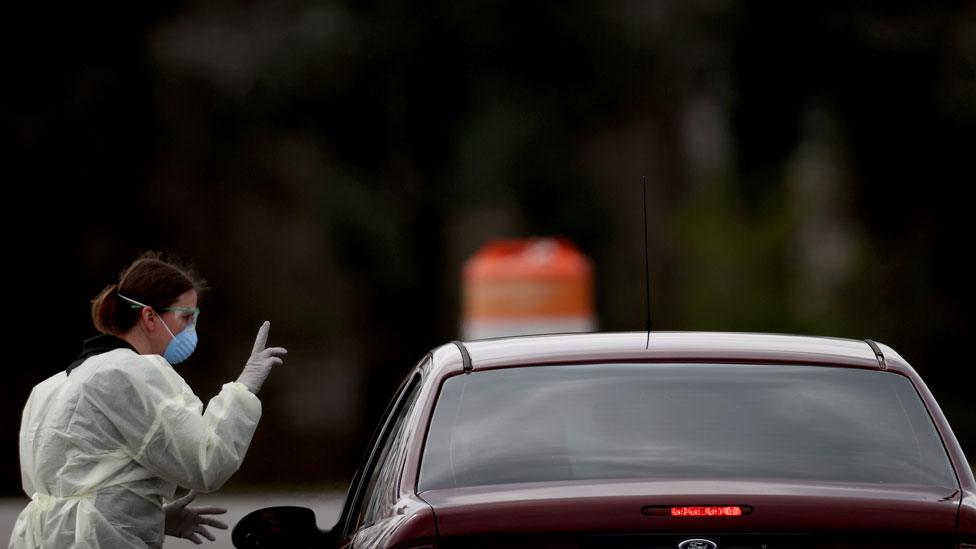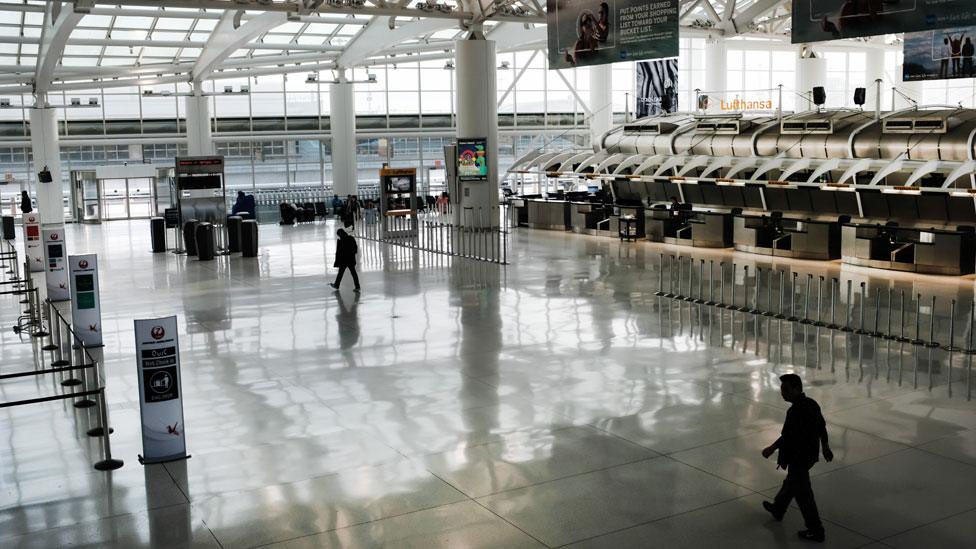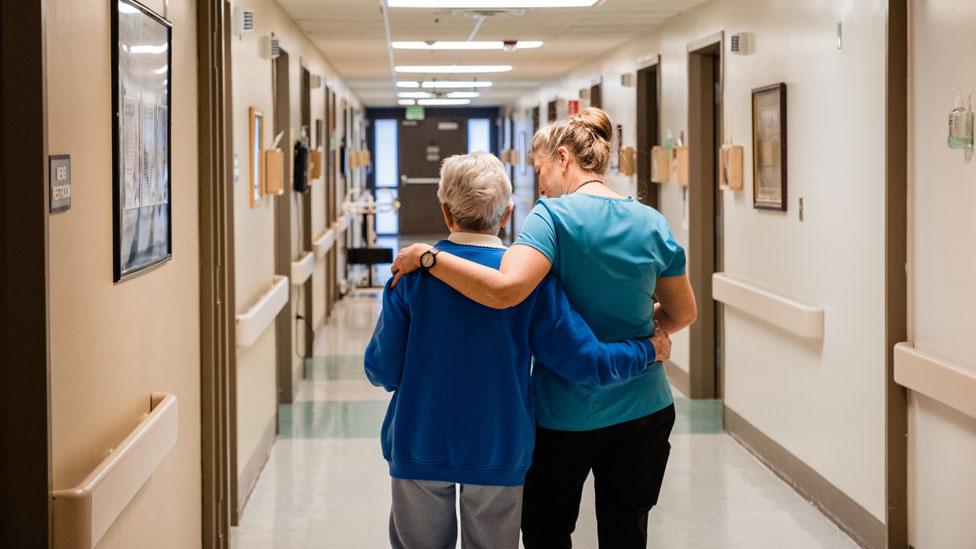Coronavirus: Will US be ready in the weeks ahead?
- Published

Covid-19's spread across the US has been on a steady rise - and the disease has yet to reach its peak stateside. What's to come in the weeks ahead?
As US infectious diseases chief Dr Anthony Fauci put it recently: "It's certainly going to get worse before it gets better."
Here's what public health experts have to say about what the US can expect from the coronavirus.
What's going to happen next?
Dr Gregory Poland, director of Mayo Clinic's Vaccine Research Group, says analysing a new disease is like looking at a pixelated image - when you've only rendered 30%, it's impossible to tell what the photo is. Once you load 70%, the picture gets clearer, and so on.
"We're in that 30 to 50%," Dr Poland says of Covid-19. "There's a lot we genetically know about coronaviruses [and] a huge amount we don't know, clinically, epidemiologically and seasonally with regards to this virus."
Worst case, Dr Poland says, based on early models, between 40 to 70% of the US will be infected. That's between 132 and 231 million people.
One factor to consider is how Covid-19 is mutating - at a rate about once every other week. Dr Poland says it could be turning less virulent, as happens with other similar viruses.
"With 40% infected and if there was a 1.6% case fatality rate, that would be about 2.2 million people who would die, but in a real-world case scenario the fatality rate is likely to be lower than that," Dr Poland explains, as we don't know how many people are infected but asymptomatic, for example. "It's a really foggy crystal ball and really difficult to make predictions."
Dr Poland says the next best-case scenario is that doctors figure out an existing antiviral can be used to treat Covid-19. Otherwise, hopefully within the next year, scientists can develop a vaccine or other treatment therapy.
"Worst case, none of those happen in a timely manner," he says. "If we don't do anything? That's tens of thousands of deaths. Hundreds of thousands possible hospitalisations."


EASY STEPS: How to keep safe
A SIMPLE GUIDE: What are the symptoms?
TOUCHING STUFF: How long does it last on surfaces?

Even if Covid-19 drops to the level of the seasonal flu, if 40-70% people are infected, it will still cause a high number of deaths and hospital stays, especially among those 60 and older.
"These next couple of weeks are really going to be critical. Are we going to start seeing a tip over into widespread community transmission or is it going to be relatively slow? I think these next few weeks are critical and all of us in this field are holding our breath to see what happens."
Dr Poland says based on the history of similar diseases, Covid-19 may dampen or entirely disappear in the heat of summer, like SARS did in 2003. If not, it will probably circulate until it exhausts most susceptible people.
"It really is speculation," he emphasises. "What happens in China is not necessarily generalisable to the US culture, and you make your best case and try to add data point-by-point to the pixelation."
How prepared is the overall health system?
Dr Leana Wen, an emergency physician and public health professor at George Washington University, warns the US healthcare system stands to be "completely overwhelmed" by a serious outbreak in its current state.
Dr Wen, who previously served as the city of Baltimore's Public Health Commissioner, says the US is "critically short" of key supplies, like ventilators, protective equipment for healthcare workers and even hospital space.
In a moderate outbreak as predicted by the US health agency, some 200,000 hospital intensive care beds would be required, she explains.
"There are currently less than 100,000 beds right now and most of them are occupied. If there were a need for 200,000 beds and they came within a short period of each other, then we would be in a situation like Italy and Wuhan, China, where they had to ration care...Where healthcare workers had to make difficult decisions about who will get lifesaving care and who will go without."
Dr Wen says that without any intervention, there will be a sharp escalation in the number of infected individuals - about 5% of whom will require intensive care.
How to flatten the curve?
It will be essential to spread the rate of infections over a longer period of time - flattening the curve, as it were - to reduce the number of Americans who need hospital care at one time and thus keep the system from becoming overburdened.
Keeping the spike of serious infections manageable is possible, Dr Wen says, depending on the actions people - and governments - take today.
"Individual and collective actions are what will make a difference in the trajectory of this illness right now," she says. "Every single action that is part of social distancing is helpful. Everything is helpful. This is not a time to let perfect be the enemy of the good."

JFK airport in New York is eerily quiet
She adds that the US "absolutely" needs a national response. "This is a disease that knows no boundaries between local and state."
And ideally, officials should ensure everyone can get tested so we know how much the coronavirus has spread in our communities, Dr Wen says.
One US pathologist told the BBC that hospital laboratories across the country were ready to develop test assays five weeks ago but were unable to move forward due to existing FDA regulations. Now, as these rules have been walked back in recent weeks, labs are able to work on developing tests, a month and a half later.
What about at the state level?
Many of the issues in responding to the coronavirus in the US are tied to states' rights. Each state has its own specific health policies. All 50 have the capacity to declare a public health emergency and free up resources, though it may be done through different authorities in each state. Most states have now done so.
Dr Georges Benjamin, executive director of the American Public Health Association, describes the situation as a partnership at the local, state and federal levels, but one that can have gaps based on funding or differing political views about how involved the government should be.
"We are not as prepared as we should be," Dr Benjamin told the BBC. "We have not had a year without a public health emergency since 2011. But this is the big one we have been predicting."
Among the issues at play are an "underfunded public health system, a just-in-time healthcare delivery system and an under-practiced preparedness system," according to Dr Benjamin.

Rural hospitals fear they could be swamped
A 2020 report by the Trust for America's Health, external put 25 states and the nation's capital in the high health preparedness tier. Twelve were middle and 13 were deemed low.
The study found public health funding, hospital safety and flu vaccination rates had improved overall, but other measures, including clean water supply and paid sick leave had "stalled or lost ground" in the last year. Only 30% of hospitals on average earned top patient safety grades; only 55% of workers reported access to paid leave; only 49% of Americans get a flu jab.
"The lesson from this must be to improve the infrastructure of the US public health system and sustain it; use innovation to scale up the health care delivery system and recognise preparedness as a national infrastructure that must be supported," Dr Benjamin says.
So far, 12 states - including Florida, New York, California, and Washington state - have shut or enacted restrictions on bars and restaurants. Thirty-eight have closed public schools, along with a number of districts in other states.
As the country enters mitigation mode, Dr Benjamin says he expects to see all kinds of these social distancing measures used at the state-level.
"No state is yet adequately prepared to completely respond to this pandemic," he adds. "We are getting better at responding, but it remains a challenge."
What about Canada?
Last week, the Canadian government ramped up its response to the coronavirus pandemic. Prime Minister Justin Trudeau advised Canadians to postpone or cancel all non-essential international travel outside of Canada.
Canada announced a C$10bn ($7.1bn; £5.7bn) programme to help businesses with a "significant" stimulus programme coming next week.
Additionally, the Bank of Canada slashed the central bank's key lending rate by 50 basis points to 0.75%, the second cut this month.
All cruise ships carrying over 500 passengers will not be able to dock in Canada until 1 July and the number of airports where international flights can land will be limited to enhance screening.
A number of provincial governments have taken their own steps in recent days to limit contagion amid some complaints that federal counterparts had not taken an aggressive enough stance.
Ontario and Quebec have closed all public schools for the next two weeks. British Columbia and Quebec have banned all public gatherings of over 250 people.